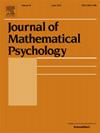A Coupled Hidden Markov Model framework for measuring the dynamics of categorization
IF 1.5
4区 心理学
Q2 MATHEMATICS, INTERDISCIPLINARY APPLICATIONS
引用次数: 0
Abstract
We introduce a new framework for measuring the dynamics of category learning using Coupled Hidden Markov Models (CHMMs). The key assumptions of the framework are that people maintain a latent assignment of every stimulus to a category, and that they can update the assignments for all stimuli whenever they encounter any stimulus. These assumptions contrast with many existing accounts of category learning, which either do not allow for what is learned about one stimulus to influence the category association of others, or allow only for indirect influence. The CHMM framework allows tailored models to be developed for specific category learning tasks, taking as input the stimulus sequence and category responses people make, and producing as output inferences about the underlying dynamics of category assignments and the mechanics of the response processes. We demonstrate the framework by applying it to a categorization task considered by Lee and Navarro (2002), showing how the model measures the change in participants’ latent category assignments as they learn the category structure. We conclude by discussing potential applications of the CHMM framework to category learning situations involving prior knowledge, changing category structures, and category learning tasks that involve the consideration of multiple stimuli at one time.
测量分类动态的耦合隐马尔可夫模型框架
我们介绍了一种使用耦合隐马尔可夫模型(CHMMs)测量类别学习动态的新框架。该框架的关键假设是,人们将每个刺激物都归入一个类别,而且每当遇到任何刺激物时,他们都能更新所有刺激物的归属。这些假设与许多现有的类别学习论述形成鲜明对比,后者要么不允许所学到的关于一个刺激物的知识影响其他刺激物的类别关联,要么只允许间接影响。CHMM框架允许为特定的类别学习任务开发量身定制的模型,将刺激序列和人们做出的类别反应作为输入,并将类别分配的基本动态和反应过程的机制作为输出推论。我们将该框架应用于 Lee 和 Navarro(2002 年)所考虑的分类任务,展示了该模型如何测量参与者在学习类别结构时潜在类别分配的变化。最后,我们将讨论 CHMM 框架在涉及先验知识、不断变化的类别结构以及同时考虑多个刺激的类别学习任务中的潜在应用。
本文章由计算机程序翻译,如有差异,请以英文原文为准。
求助全文
约1分钟内获得全文
求助全文
来源期刊

Journal of Mathematical Psychology
医学-数学跨学科应用
CiteScore
3.70
自引率
11.10%
发文量
37
审稿时长
20.2 weeks
期刊介绍:
The Journal of Mathematical Psychology includes articles, monographs and reviews, notes and commentaries, and book reviews in all areas of mathematical psychology. Empirical and theoretical contributions are equally welcome.
Areas of special interest include, but are not limited to, fundamental measurement and psychological process models, such as those based upon neural network or information processing concepts. A partial listing of substantive areas covered include sensation and perception, psychophysics, learning and memory, problem solving, judgment and decision-making, and motivation.
The Journal of Mathematical Psychology is affiliated with the Society for Mathematical Psychology.
Research Areas include:
• Models for sensation and perception, learning, memory and thinking
• Fundamental measurement and scaling
• Decision making
• Neural modeling and networks
• Psychophysics and signal detection
• Neuropsychological theories
• Psycholinguistics
• Motivational dynamics
• Animal behavior
• Psychometric theory
 求助内容:
求助内容: 应助结果提醒方式:
应助结果提醒方式:


